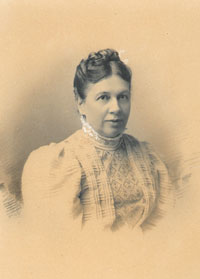Sophia Tolstaya
| Sophia Andreyevna Tolstaya | |
|---|---|
 |
|
| Spouse(s) | Leo Tolstoy |
|
Issue
13 children; 8 survived childhood
|
|
| Born | 22 August 1844 |
| Died | 4 November 1919 (aged 75) Yasnaya Polyana, Tula Governorate, Soviet Russia |
| Occupation | Diarist, copyist |
Countess Sophia Andreyevna Tolstaya (née Behrs; Russian: Со́фья Андре́евна Толста́я, sometimes Anglicised as Sophia Tolstoy; 22 August 1844 – 4 November 1919), was a Russian diarist, and the wife of Russian novelist Leo Tolstoy.
Sophia Behrs was one of three daughters of a German physician, Andrey Evstafievich Behrs (1808–1868), and his Russian wife, Liubov Alexandrovna (née Islavinа; 1826–1886). Her maternal great-grandfather, Count Pyotr Zavadovsky, was the first minister of education in Russia's history. Sophia was first introduced to Leo Tolstoy in 1862, when she was 18 years old. At 34, Tolstoy was 16 years her senior. On 17 September 1862 the couple became formally engaged after Tolstoy gave Sophia a written proposal of marriage, marrying a week later in Moscow. At the time of their marriage, Leo Tolstoy was already well known as a novelist after the publication of The Cossacks. On the eve of their marriage, Tolstoy gave Sophia his diaries detailing his sexual relations with female serfs. In Anna Karenina, 34-year-old Konstantin Levin, a semi-autobiographical character behaves similarly, asking his 19-year-old fiancée Kitty to read his diaries and learn of his past transgressions. The diary included the fact that he had fathered a child by a woman who remained on the Yasnaya Polyana estate. In Anne Edwards' Sonya: The Life of Countess Tolstoy, she describes Sophia as having a deep fear that Tolstoy would somehow re-enter a relationship with the other woman.
The Tolstoys had 13 children, eight of whom survived childhood. The family was prosperous, owing to Tolstoy's efficient management of his estates and to the sales of his works, making it possible to provide adequately for the family. Sophia acted as copyist of War and Peace, copying and editing the manuscript seven times from beginning to end at home at night by candlelight after the children and servants had gone to bed, using an inkwell pen and sometimes needing a magnifying glass to read her husband's notes.
...
Wikipedia
